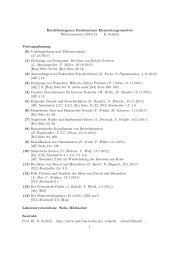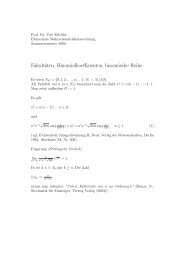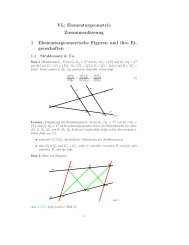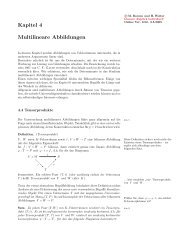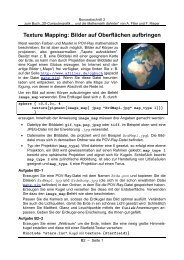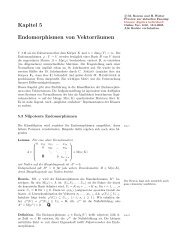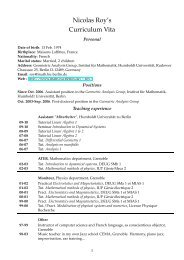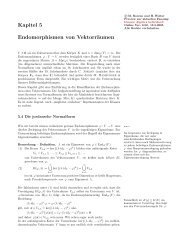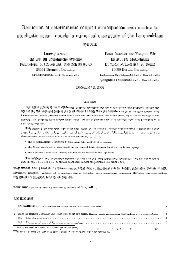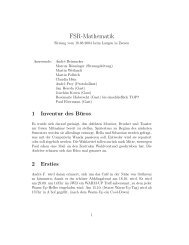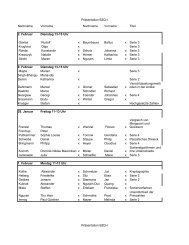Berlin PUM Workshop 2012 - Institut für Mathematik - HU Berlin
Berlin PUM Workshop 2012 - Institut für Mathematik - HU Berlin
Berlin PUM Workshop 2012 - Institut für Mathematik - HU Berlin
Create successful ePaper yourself
Turn your PDF publications into a flip-book with our unique Google optimized e-Paper software.
<strong>Berlin</strong> <strong>PUM</strong> <strong>Workshop</strong> <strong>2012</strong><br />
Analysis and Application of the GFEM, XFEM, MM<br />
22 – 24 August <strong>2012</strong>, <strong>Berlin</strong>, Germany<br />
Multi-level unsymmetric hanging nodes in hp-adaptive GFEM<br />
Andreas Byfut<br />
Department of Mathematics, Humboldt-Universität zu <strong>Berlin</strong>,<br />
Unter den Linden 6, 10099 <strong>Berlin</strong>, byfut@math.hu-berlin.de<br />
Andreas Schröder<br />
Department of Mathematics, Humboldt-Universität zu <strong>Berlin</strong>,<br />
Unter den Linden 6, 10099 <strong>Berlin</strong>, schroder@math.hu-berlin.de<br />
Keywords: GFEM, higher-order, hanging nodes, XFEM, fictitious domain method<br />
ABSTRACT<br />
In this presentation, the concept of constrained approximation for standard higher-order finite<br />
element methods is carried over to the generalized finite element method (GFEM). As a consequence,<br />
meshes containing multi-level, unsymmetric hanging nodes may be employed in h- and<br />
hp-adaptive GFEM.<br />
Considering the ability of GFEM to include almost arbitrary functions into its finite element<br />
space, one may conclude that adaptivity is generally unnecessary to approximate the solution<br />
of a given problem “well”. However, an (automatic) problem-dependent composition of a set<br />
of enrichment functions as well as an (automatic) inclusion into the finite element spaces is a<br />
non-trivial task to appropriately cover each and every possible feature of a sought solution. In<br />
modern higher-order finite element schemes, h- and hp-adaptivity based on a posteriori error<br />
control is a standard tool to (automatically) increase the approximation quality of a finite<br />
element scheme. This presentation will show, that these standard techniques may very well be<br />
applied for h- and hp-adaptive GFEM such as the XFEM or the fictitious domain method, see<br />
also [1].<br />
For h- and hp-adaptivity, it is necessary to locally refine meshes. Whenever one mesh element is<br />
refined but at least one of its neighboring elements is not, then (multi-level) hanging nodes may<br />
occur, if they are not eliminated from the mesh using sophisticated refinement strategies. For<br />
the standard h- and hp-FEM, constrained approximation is the technique of choice to ensure<br />
the continuity of finite element shape functions associated to these hanging nodes, see also<br />
[1,2]. This presentation will show, how constrained approximation for standard FEM based<br />
on Lagrange, integrated Legendre and Gauss-Lobatto polynomials can be carried over to the<br />
GFEM, to allow for h- and hp-adaptivity with the appropriate convergence rates.<br />
REFERENCES<br />
[1] A. Byfut and A. Schröder. hp-Adaptive Extended Finite Element Method, Int. J.<br />
Numer. Meth. Engng., Vol. 89, 1392–1418, <strong>2012</strong>.<br />
[2] A. Schröder. Constraints Coefficients in hp-FEM. Numerical Mathematics and Advanced<br />
Applications, Springer <strong>Berlin</strong> Heidelberg, 183–190, 2008.<br />
26



